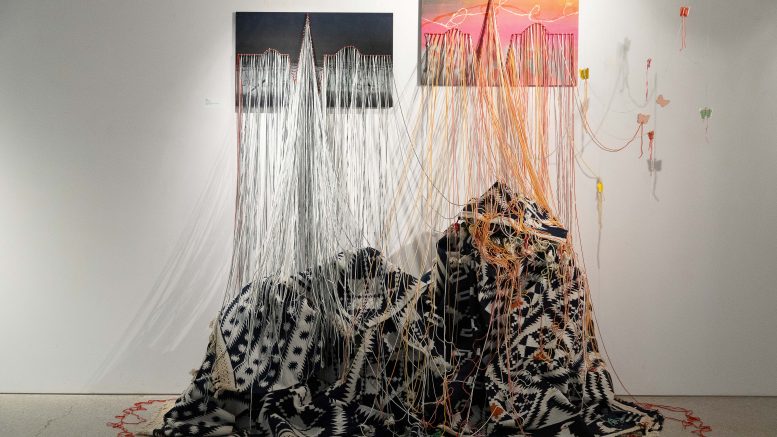Kiran Sran, a third-year fine arts student, unveiled her solo exhibition Belonging and Heritage at the School of Art Student Gallery last week.
For many, the ideas of belonging and heritage might conjure ideas of one’s own genealogy or birthplace, but Sran wanted to explore these concepts as an integral and shared aspect of humanity.
“I am trying to focus on the collective human experience of not just a cultural identity and heritage, but also its loss and also looking at [the heritage of] a global community, not individually based on our cultures or religions,” Sran said.
Some of the works in the exhibition explore the natural world as heritage. For example, “I am home” is a painting dedicated to St. Adolphe, Manitoba and depicts a chimney swift, a local bird loved by the community.
“Land and Its Flowers,” on the other hand, is a collage of paintings that shows how paying attention to nature can unite people across differences.
“These are all the endangered flowers across the globe […] You will see a little map flowing through it, and the different depths of the canvases are directly proportional to what their status [is] now [or] how endangered [they are]. So the ones that are really pushed back into the wall are now extinct,” she explained.
“This is [what will happen] if we don’t see everything around us as a common heritage, as a collective human experience. Division leads [to extinction], so if we can just look past that, there’s a lot more that we have inherited from mother nature.”
Additionally, the artwork in this collection touches upon the theme of immigration. Sran was born in India and later moved to Canada, leaving her stuck between the two cultures. This can be seen in “Self portrait,” a ceramic bust made of hollow hexagonal puzzle pieces, suggesting incompleteness and estrangement.
“Biji and me” also depicts immigration and is one of Sran’s favourite paintings. She painted a portrait of her grandmother over a world map, symbolizing how she was her world.
“While she was alive, she kept us all together, [but] everybody has moved away from home, so the families are scattered, siblings are scattered, and it’s not the same anymore. But it’s a common, collective experience of every immigrant family that when you move away from home, you lose the language, the culture and everything else,” she said.
“I painted my own portrait also and cut it into puzzle pieces [and] slapped it back on the canvas so you could see my hair. It’s a tiny bit of me, but this is how I feel.”
Sran holds a bachelor’s and master’s degree in medical physiology and works in clinical research, but she felt compelled to start a degree in fine arts because art has always made her feel grounded and connected. She urged students to, as she has done — find a way to be connected to the world.
“I would like them to think about what belonging [means] to them, and remember also we are all one, regardless of what we look like, what we eat, what language we speak, and to see more common grounds, to find those rather than look] for division,” she concluded.
Belonging and Heritage concludes on Oct. 22. Visit umanitoba.ca/art/student-gallery for upcoming exhibits at the School of Art Student Gallery.




